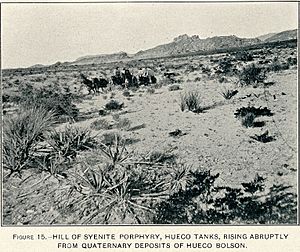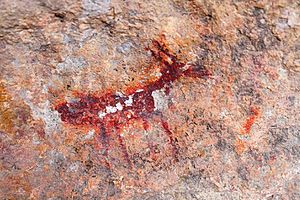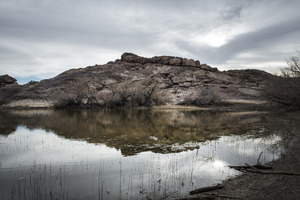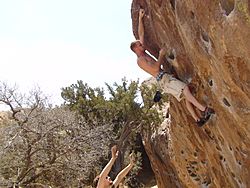Hueco Tanks facts for kids
|
Hueco Tanks
|
|
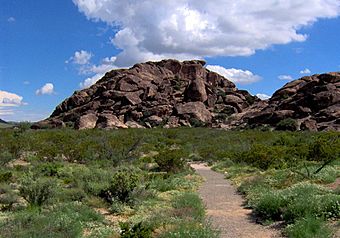
East Mountain at Hueco Tanks
|
|
| Nearest city | El Paso, Texas |
|---|---|
| Area | 860 acres (350 ha) |
| NRHP reference No. | 71000930 |
Quick facts for kids Significant dates |
|
| Prehistoric | 1000-1499 AD |
| Historic Aboriginal | 1500-1824 |
| Added to NRHP | July 14, 1971 |
| Designated NHL | January 13, 2021 |
Hueco Tanks is a special area in El Paso County, Texas, United States. It has low mountains and is a very important historic site. It sits in a high desert area. The Franklin Mountains are to its west, and the Hueco Mountains are to its east.
The word Hueco comes from Spanish and means hollows. This name refers to the many natural holes and dips in the rocks. These holes collect and hold rainwater. Because of its unique history, plants, and animals, Hueco Tanks is protected by Texas law. It is against the law to remove, change, or destroy anything there.
This historic site is about 32 miles (51 km) northeast of central El Paso, Texas. You can get there by taking Montana Avenue (U.S. Route 62/U.S. Route 180) and then turning onto RM 2775. The park has three mountains made of syenite (a type of rock like granite). It covers 860 acres (348 hectares). People enjoy visiting for fun activities like birdwatching and bouldering. Hueco Tanks is also very important to many Native American groups. This is partly because of the ancient pictographs (rock paintings) found there. Many of these paintings are thousands of years old.
Contents
- Becoming a Park: Hueco Tanks' Designation
- A Journey Through Time: The History of Hueco Tanks
- Ancient Art: The Pictographs of Hueco Tanks
- The Rocks and Water: Geology of Hueco Tanks
- Amazing Creatures: Wildlife at Hueco Tanks
- Unique Plant Life: Plants at Hueco Tanks
- Climbing Adventures: Rock Climbing at Hueco Tanks
Becoming a Park: Hueco Tanks' Designation
Hueco Tanks State Park & Historic Site became a public park in a few steps. The county gave part of the land on June 12, 1969. Then, 121 more acres were bought on August 10, 1970. The park first opened to visitors in May 1970. This 860.3-acre park is named for the large natural rock basins. These "huecos" have provided rainwater to people for thousands of years in this dry part of west Texas.
A Journey Through Time: The History of Hueco Tanks
Hueco Tanks has changed a lot over time. It was owned by private families and then became a public park. You can see names carved by Texas Rangers and US Cavalrymen. There are also many Native American artifacts and paintings. All these things show its rich history.
The main reason people came to this area was for water. The huge rocks and boulders have cracks and holes called "huecos." These holes trap rainwater and hold it for months. Early travelers found this out. They left pictures and symbols on the rocks to tell future visitors about this important water source.
Who Lived Here First? Early Inhabitants

People have lived in the Hueco Tanks area for about 10,000 years. The first known group was the Desert Archaic Culture. These people ate foods like mesquite beans, banana yucca, and cactus fruits. Over time, different groups lived here. These included the Paleo-Indians, who hunted large animals using special spear points called Folsom points.
Later, the 'Jornada Mogollon' people (pronounced mo-goi-YONE) lived here. An archaeological dig found that Hueco Tanks was once a Jornada Mogollon village. Around 700 years ago, the village became too big for the small farming area. So, people moved to nearby flat areas to the south, west, and northwest. They lived well there until about 1450 A.D., when there were many serious droughts. By about 1600 A.D., the Apache people, who came from Canada, lived in the region.
Farming started in the area around 1000 A.D. This led to the growth of the Jornada Mogollon Culture. The Jornada people built a village and grew corn.
Later, the area was used by Mescalero and Lipan Apaches, and Jumano people. The Comanche, Kiowa, and Tiguas also visited. Spanish and Mexican travelers did not come to the area often. The Kiowa called the area Tso-doi-gyata-de-dee, which means "rock cave where they were surrounded." In 1837, the Kiowa signed a treaty with the United States. However, Mexican soldiers later trapped them in Hueco Tanks for six days. Most of them died during this time. The oldest known modern drawings by non-Native people are from the 1840s.
Becoming a State Park: Modern History
In 1852, John Russell Bartlett, a United States Boundary Commissioner, visited the area. He wrote about some of the rock paintings. From 1858 to 1859, the Butterfield Overland Mail had a stagecoach station here. But they moved when they found a better spot to the south.
In 1895, an El Paso businessman named Juan Armadariz bought much of the Hueco Tanks land for ranching. Silverio Escontrías bought the land from Armendariz in 1898. His family used it as a ranch and a place for tourists until 1956. The early El Paso Archaeological Society (EPAS) wanted the land to become a park. In 1935, the National Park Service offered to buy the land, but the Escontrías family said no.
In the 1940s and 50s, Fort Bliss rented land from the Escontrías family for training. In 1956, the ranch was put up for sale. During this time, groups interested in history and archaeology helped people understand how important the area was. El Paso County took over the land in the mid-1960s. In 1969, the El Paso County commissioners decided to give the park to the Texas Parks and Wildlife Commission. It became a Texas State Park in 1970. The park's information center is in the old Escontrías ranch house. Hueco Tanks was added to the National Register of Historic Places in 1971. In 1998, it was named the Hueco Tanks State Historic Site.
Ancient Art: The Pictographs of Hueco Tanks
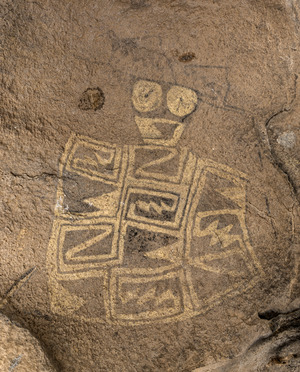
The first paintings at Hueco Tanks were made by the Desert Archaic Culture. These were abstract designs created between 6000 and 3000 B.C. Later, between 3000 BC and 450 A.D., people drew pictures of animals and humans on the rocks.
Most of the pictographs at Hueco Tanks were made by the Jornada Mogollon people. These drawings might have been part of prayers for rain. The Jornada religion was influenced by Mesoamerican religions. Many drawings at Hueco Tanks show Tlaloc, a rain god, and Quetzalcoatl.
Modern drawings by non-Native people started appearing when someone painted "1849" over some of the original pictographs.
The first scientific study of the rock paintings happened in 1939. Forrest and Lula Kirkland recorded the art. Most colors used in the paintings came from minerals found in the area. The paintings became part of the rock as they aged.
In 1972, the El Paso Archaeological Society (EPAS) and the Anthropology Club of the University of Texas at El Paso (UTEP) carefully recorded the drawings. They noted their condition and sometimes moved and checked the rock art. This project found 300 paintings that had not been recorded before. Their findings were published in a book in 1974. In 1988, a park ranger and an archaeologist mapped the location of all known pictographs. A digital database of the art and its GPS coordinates was started in 1999.
The Rocks and Water: Geology of Hueco Tanks
The syenite rock formation at Hueco Tanks formed about 34-38 million years ago. It was part of a larger mountain range, the Hueco Mountains. These mountains are over 320 million years old. Back then, this area was covered by an inland sea. Over time, the syenite rock was uncovered by weather. This created the rock formations you see today, which stick out from the desert floor.
The "tanks" (hollows) in the rocks could once hold a year's supply of water. There are also several permanent and seasonal springs in the area. The region gets less than 14 inches (35 cm) of rain each year.
The syenite rock is covered with 'desert patina'. This is a dark coating that forms over thousands of years. It is caused by the sun, sand, and water weathering the rock surface. The site is very important to many Native American groups. These include the Mescalero Apache, the Kiowa, the Hopi, and the Pueblo people. This importance is shown in the pictographs (rock paintings) found throughout the area. Some of these are thousands of years old. Hueco Tanks has the most mask paintings by Native Americans in North America. Hundreds of them are found here.
Amazing Creatures: Wildlife at Hueco Tanks
Many interesting animals live at Hueco Tanks. Freshwater shrimp and spadefoot toads survive in the water pools. Because of this, visitors are asked not to touch the water. This helps protect the eggs of these animals. Other amphibians seen in the park include barred tiger salamanders. About 30 different kinds of reptiles live in the area.
In 2002, 222 different kinds of birds were seen at the site. Migratory birds like waterfowl and songbirds pass through during migration seasons. Several birds likely breed here. These include the prairie falcon, burrowing owl, white throated swift, black-chinned hummingbird, ash throated flycatcher, Crissal thrasher, blue grosbeak, Scott's oriole, and lesser goldfinch.
The park is also home to many mammals. You might see mule deer, black bears, bobcats, gray fox, coyotes, badgers, ringtails, skunks, raccoons, and mountain lions. Smaller animals include black-tailed jackrabbits, desert cottontail, eastern cottontail, six kinds of bats, and twenty kinds of rodents.
Unique Plant Life: Plants at Hueco Tanks
Around the syenite rock formations, the park is surrounded by Chihuahuan Desert plants. The creosote bush is the most common plant. Hueco Tanks has enough water to support live oaks and junipers. These trees are left over from the last ice age. Other trees found here include netleaf hackberry, Texas mulberry, Mexican buckeye, Gregg acacia, and Arizona oak. Hueco Tanks is the only place in the United States where the plant Colubrina stricta grows naturally.
Climbing Adventures: Rock Climbing at Hueco Tanks
Hueco Tanks is known worldwide as one of the best places for bouldering. Bouldering is a type of rock climbing done on low rocks without ropes for safety. It is special because of its unique rock type and the many high-quality climbing routes. During the climbing season, which is usually from October to March, climbers from Europe, Asia, and Australia often visit the park.
In February, a bouldering competition called the Hueco Rock Rodeo takes place. This is a world-class outdoor event that attracts many professional climbers each year. Since June 2000, new rules have been in place. More than two-thirds of the park can only be visited with a volunteer or paid guide. Only North Mountain can be accessed without a guide. Even then, only about 70 people are allowed at a time. The south side at ground level is closed to the public.
The park offers camping and showers for $12 per night (as of April 2020). Many climbers prefer to stay at the nearby Hueco Rock Ranch. There, climbers can relax and meet other climbers. This is also where you can find paid guides, and where many volunteer guides stay during the climbing season.




